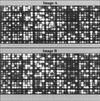cDNA array analysis of cag pathogenicity island-associated Helicobacter pylori epithelial cell response genes
- PMID: 11598072
- PMCID: PMC100077
- DOI: 10.1128/IAI.69.11.6970-6980.2001
cDNA array analysis of cag pathogenicity island-associated Helicobacter pylori epithelial cell response genes
Abstract
Helicobacter pylori strains containing the cag pathogenicity island (PAI) induce NF-kappaB activation and interleukin-8 secretion in gastric epithelial cells. The aim of this study was to investigate changes in epithelial gene expression induced by cag PAI-positive and -negative strains of H. pylori using high-density cDNA array hybridization technology. Radio-labeled cDNA prepared from H. pylori-infected Kato 3 gastric epithelial cells was hybridized to high-density cDNA arrays to identify changes in epithelial gene expression compared to noninfected controls. In vivo expression of selected, differentially expressed genes was examined by reverse transcription-PCR analysis of H. pylori-positive and -negative gastric mucosa. Screening of ca. 57,800 cDNAs identified 208 known genes and 48 novel genes and/or expressed sequence tags of unknown function to be differentially expressed in Kato 3 cells following H. pylori infection. Marked differences in gene expression profiles were observed following cag PAI-positive and cag PAI-negative infection with 15 novel cDNAs and 92 known genes being differentially expressed. H. pylori was found to change the expression of genes encoding growth factors and cytokine/chemokines and their receptors, apoptosis proteins, transcription factors and metalloprotease-disintegrin proteins (ADAMs), and tissue inhibitors of metalloproteinases. Gastric differential expression of selected known genes (amphiregulin and ADAM 10) and a novel gene (HPYR1) was confirmed in vivo in patients with H. pylori infection. Confirmation of the in vivo expression of selected genes demonstrates the usefulness of this approach for investigating pathogen-induced changes in host gene expression.
Figures






References
-
- Akopypants N S, Clifton S W, Kersulyte D, Crabtree J E, Youree B E, Reece C A, Bukanov N O, Drazek S E, Roe B A, Berg D E. Analyses of the cag pathogenicity island of Helicobacter pylori. Mol Microbiol. 1998;28:37–54. - PubMed
-
- Backert S, Ziska E, Brinkmann V, Zimny-Arndt U, Fauconnier A, Jungblut P R, Naumann M, Meyer T F. Translocation of the Helicobacter pylori CagA protein in gastric epithelial cells by type IV secretion apparatus. Cell Microbiol. 2000;2:155–164. - PubMed
-
- Beg A A, Baltimore D. An essential role for NF-κB in preventing TNF-alpha-induced cell death. Science. 1996;274:782–784. - PubMed
Publication types
MeSH terms
Substances
LinkOut - more resources
Full Text Sources
Medical

